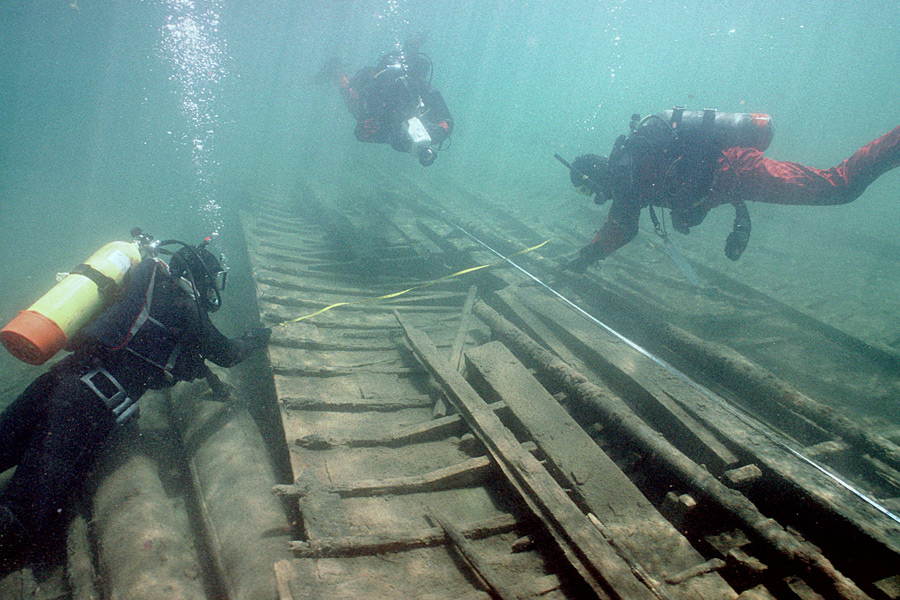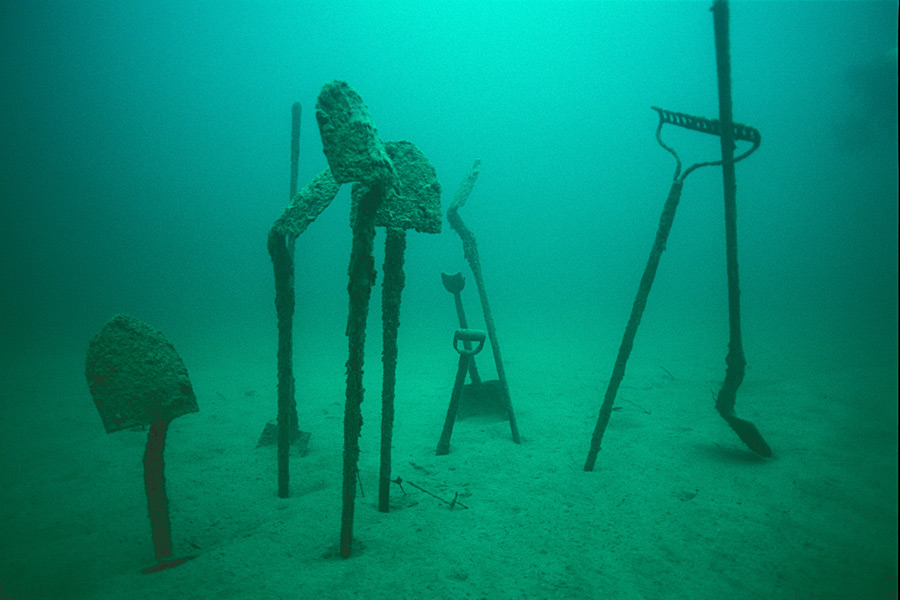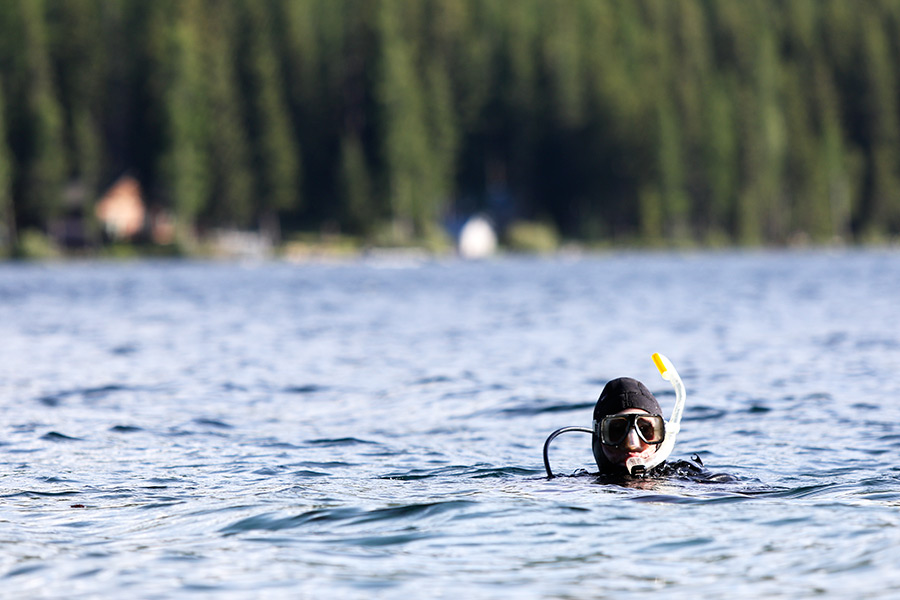MARION — The calm evening sheen of McGregor Lake filled the backdrop as Mike Ferda climbed into a burly waterproof suit bristling with hoses and valves. Before strapping on a 30-pound oxygen tank and pulling on his mask, he spit in the lenses. ¶ “People were not made to go underwater,” he said. ¶ Regardless, Ferda and two others waded into the cool lake and slowly submerged into darkness. Moments later, all that remained atop the surface were a red buoy and bubbles.
Welcome to the heart of Montana’s scuba diving country, the wild interior of the Flathead Valley, an underwater paradise as scenic as the surrounding mountain peaks.
With the largest freshwater lake in the West among more than 500 aquatic attractions, this region boasts crystalline waters and vast submarine labyrinths that satisfy hardcore divers and recreational hobbyists who enjoy year-round explorations.
The maritime reputation of this corner of the state is rather unsung and exists mostly on the fringe, similar to other niche sports such as skydiving.
But tradition runs deep in this region, fueled by unique natural wonders, sunken treasures and some of the most awe-inspiring bodies of open water in the West, including Flathead Lake and the wilderness waters of Glacier National Park.
The local diving culture is slowly rising from the depths of the recession after years of sitting dormant due to a blow to the recreation industry. Two dive shops in Kalispell fell victim to the shrinking economy. But a new family-owned shop has re-emerged between Kalispell and Whitefish and is trying to be a catalyst for the hobby and its community of diehard enthusiasts.
“This town had a huge dive population. They used to put on an event every summer called Dive Fest and hundreds of people from across Montana would come here to dive,” said Mark Cook, who opened Rock Bottom Diving nearly two years ago on U.S. Highway 93 North with his two sons, Tim and Nick.
“The dive community kind of fell apart when the economy went bad, and we’ve been trying really hard to bring it back. Now I’m meeting more people who are dusting off their old equipment and coming in to fill tanks.”
Moving to Montana may have seemed like a quixotic enterprise for a prospective dive shop, but the family soon realized that this is truly a mecca of opportunities.
“It’s crystal-clear water here. Normally lakes are murky and have algae blooms, but these are unbelievable crystal-clear lakes,” Cook said.
“All of the lakes up here have something unique to see, and there are so many of them,” Tim Cook added.
The family’s business, located in one of the former dive shops, now acts as a centralized hub for the valley’s divers. It houses a large pool that is 12 feet deep, filled with salt water and warmed to 80 degrees, making it easier for new trainees to dive into the sport. Cook helps people of all ages seeking all levels of underwater skills, from families preparing for a vacation in the Caribbean to the local search and rescue crews needing advanced, technical training.
Cook began diving in 1967, before it became more mainstream in the 1980s with the advent of new, easier-to-use gear that popularized family adventures.
As most people do, he remembers his first dive. He was 14 off the coast of California.
“I sat at the bottom of the ocean on the sand, wide eyed. A big crab floated by,” he said. “It was another world. It was just so cool. It was what I always dreamed of doing.”
From there, he embarked on a lifelong journey that continues today.
“It is still the last frontier. Seventy-percent of the Earth is underwater and less than 5 percent of it is explored,” he said.
Indeed, the same can be said about Montana.
There are 1,494 square miles of water across the state, and a large portion is in this corner of the state.
“Some of the best diving in the state is up here,” said Ferda, the assistant police chief in Whitefish who began diving 10 years ago and remains an avid enthusiast.
Last week marked the resurgence of the weekly “Dive and Dine” assemblies, an event loosely organized by Ferda and the community of local explorers as a fun way to discover various lakes around the valley with fellow divers and have dinner afterward. The inaugural gathering was at McGregor Lake, one of the best diving spots in the region due to its supreme clarity, relatively warm temperatures and abundant sight-seeing opportunities, including towering underwater cliffs, massive submerged logs and the “Geodome,” an underwater structure that makes for a memorable exploration.
“It’s really all about the camaraderie, and it’s a reason for people to get together in the water and blow bubbles,” Ferda said.
Ten years ago, the weekly summer assemblies regularly attracted upwards of 30 men and women from across the region.
Last week’s gathering drew three, but it was no less exciting. The three men dove for 40 minutes, going as far down as 79 feet underwater.
One of those men was Kyren Zimmerman, a 24-year-old who grew up in Kalispell. Zimmerman has similarly developed a newfound passion for diving. He picked the hobby up in recent years as a way to inform his love of the outdoors and his passion for wildlife and habitat conservation. Now he frequently travels the world, diving in Fiji or off the coast of Australia, helping wildlife biologists count sharks or film native fish populations for documentaries and youth education.
“The aquatic environment is a whole new world in itself. I get to incorporate my diving with my conservation work, which I love,” the 2009 Flathead High School graduate said.
“Taking those first breaths underwater, it’s such a surreal experience.”
Last summer, Zimmerman began exploring the remote lakes across the valley. He and some friends hiked into Iceberg Lake in Glacier National Park with diving gear, and he dove into the frigid waters to see what was hidden below. Within minutes, the icy water froze his equipment. In a separate adventure, he dove underwater in the Middle Fork Flathead River and filmed bull trout.
This summer he plans to explore further through Glacier as well as journey into the wilderness lakes of the Jewel Basin.
He is also collecting information on sunken ships in Flathead Lake. At least six steamboats from the early 20th century are hidden in the depths of the massive lake, along with downed airplanes, crashed train cars and more artifacts. He also wants to explore Hungry Horse Reservoir and Lake Koocanusa, two man-made lakes that buried old town sites and Native American treasures.
“The maritime history around here is fantastic,” he said.
“I have a whole stack of places I want to go check out.”
Zimmerman credits Cook for helping him develop into an advanced certified diver.
“It’s really helped me develop a new passion for diving and taking the next step,” Zimmerman said. “The diving around here is amazing and Mark does a great job and takes care of his students.”
Cook has helped countless people make the dive over the last three decades. Especially veterans. At his previous shop in Utah, Cook established a program through the Salt Lake City Veterans Affairs office that provided free training for post 9/11 vets who returned from combat. Cook himself served in Vietnam along with his brother, who died years later from the effects of Agent Orange.
“I’ve seen what combat can do to these young men,” Cook said.
Cook’s program grew into Dive Alliance, a nonprofit group that aims to help veterans through diving excursions. Cook said he saw profound impacts as men and women coped with post-traumatic stress disorder.
“Something happens underwater. They learn that they can turn it off and focus on the basics, like breathing,” he said. “It gives them control and it gives them freedom.”
Cook said he hopes to start something similar in the Flathead as a way to give back to those who served their country.
He also hopes to share the thrill of diving with others who, like Zimmerman, can then embark on a lifetime of discovery.
“Diving is something that changes your life, some people more than others,” he said. “It doesn’t matter if you’re in a lake or an ocean, it changes your life.”
Rock Bottom Diving is located at 203 Business Center Loop. Call 406-407-7819 for more information. Locations of the weekly “Dive and Dine” assemblies are posted at the dive shop and on its Facebook page.
Underwater Wonders

The Underwater Forest in Lake McDonald
Glacier National Park’s grand high-country vistas receive all the fame and attention, but there is a plethora of wondrous scenery and artifacts to explore under the surface. Lake McDonald, the park’s largest lake at 6,823 acres of surface area with depths as far down as 472 feet, is home to wrecked ships, amazing geology and submerged trees. One particular highlight is the so-called Underwater Forest near Sprague Creek, where massive a collection of ancient trees have settled into the bottom of the lake. This forest is about 100 yards east of the picnic area at Sprague Creek Campground. Summertime is the best time to adventure underwater in the park as the lake ranges from 60 degrees at the surface down to 40 degrees at 100 feet. The visibility is about 50 feet, which makes for spectacular underwater sightseeing. There is also the “Shovel Garden,” a collection of discarded tools from the late 1920s and early 30s when Going-to-the-Sun Road was being built. Many tools still stick out of the muddy lake bottom just offshore of Apgar Village. A diver flag must be displayed above water at all times and objects cannot be removed from the lake.

The Lost Towns of Lake Koocanusa
Before the Libby Dam was constructed in the late 1960s and early 1970s, several small towns and home sites occupied the scenic shores of the Kootenai River, the third largest tributary to the Columbia River. The arrival of the 422-foot-tall dam forced the eviction of the original Rexford, Marston, Jennings, Ural, Warland and Stone Hill as the river pooled up and became Lake Koocanusa. The reservoir stretches 90 miles long with a maximum depth of 370 feet. Many pioneer buildings were moved to the Tobacco Valley Historical Village in Eureka before the rising waters arrived, saving them from submersion, including a church, library and school house. However, it is believed that many artifacts and relics of the past remain hidden underwater, creating an underwater museum worth exploring. There is also believed to be artifacts from the Kootenai tribe, the area’s first inhabitants that used the Tobacco Valley as a main corridor.

The Sunken Steamboats of Flathead Lake
Barely 100 years ago, there were no roads around Flathead Lake, meaning people traveled via boat to and from the various communities of the valley. In the late 1800s and early 1900s, over 25 steamboats and barges regularly filled the largest freshwater lake in the West, carrying passengers or logging supplies. The boats ranged in size from small barges to massive ships, such as the Klondike, a steamboat that was 120 feet long and could carry 425 passengers, or the Kalispell, a sleek state-of-the-art gas-engine craft built in 1910 that ferried passengers at night between Somers and Polson. According to information provided by The Museum at Central School, at least six ships sank in the lake while plying stormy weather and tumultuous conditions. The Silver City wreck is located near Bigfork Landing. The famed Pocahontas, a passenger steamboat, made statewide news when it sunk near Melita Island in 1888. It was raised from the depths and rebuilt. But no doubt, the lake is filled with history, including sunken logs and items from sunken ships. For more information, visit the museum in downtown Kalispell.
